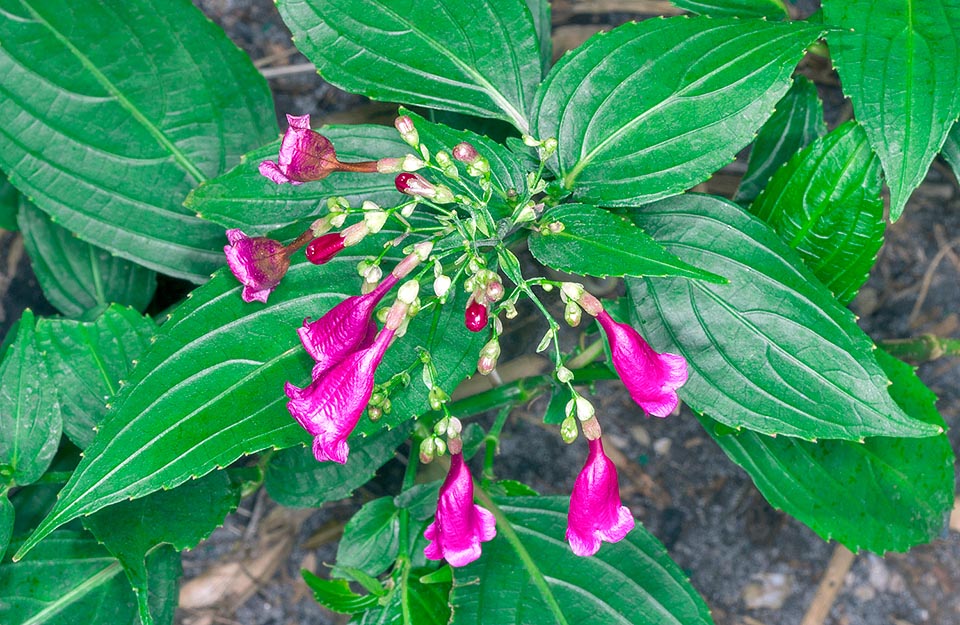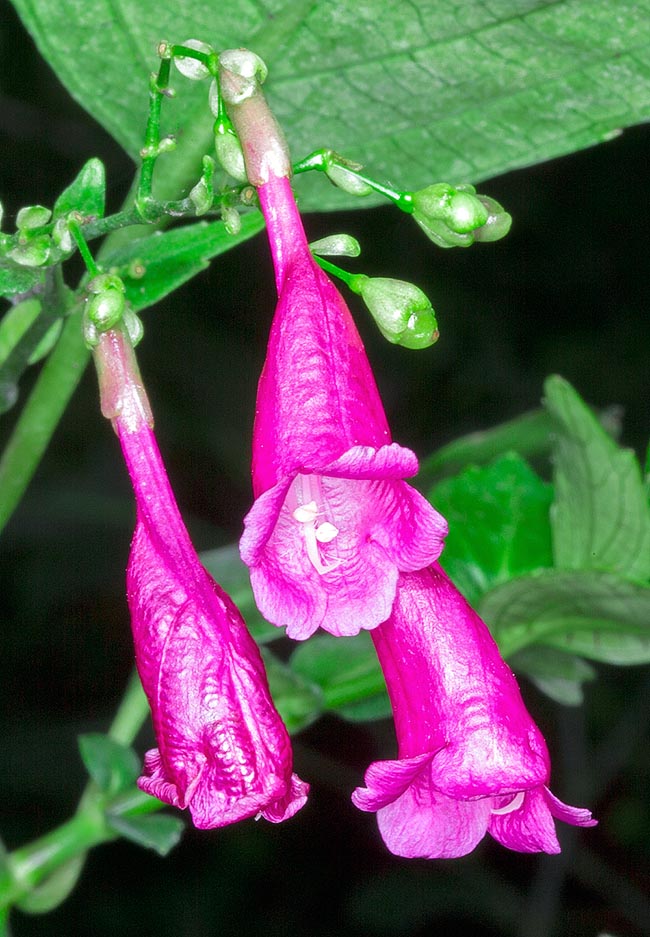Family : Acanthaceae

Text © Pietro Puccio

English translation by Mario Beltramini

Present from north-eastern India to China and southward, up to Thailand and Vietnam, where grows in the humid forests up to about 1500 m of altitude, Strobilanthes cusia is a semi-woody evergreen herbaceous plant, 0,5-1,5 m tall with pink to bluish dark violet conical flowers that at times adorn the borders in the tropical gardens © G. Mazza
The species is distributed in Bangladesh, Bhutan, China (Fujian, Guangdong, Guangxi, Guizhou, Hainan, Hunan, Sichuan, Taiwan, Xizang, Yunnan and Zhejiang), Laos, Myanmar, North-eastern India, Thailand and Vietnam where it grows in the humid forests up to about 1500 m of altitude.
The name of the genus is the combination of the Greek substantives “στρόβιλος” (strobilos) = pine cone, cone, and “ἄνθος” = flower, with reference to the shape of the inflorescence; the derivation of the specific name is not known.
Common names: Assam indigo, Chinese rain bell, room (English); rum (Assam); bǎn lán, da-ching-yeh, mǎ lán (China); kum (India); hoomz baanz (Laos); tarom (Malaysia); khraam naw ceh (Thailand); chàm lá to, chàm nhuộm, chàm mèo, thanh dại (Vietnam).

Medicinal virtues in roots and leaves that still now locally furnish the indigo dye © Giuseppe Mazza
The Strobilanthes cusia (Nees) Kuntze (1891) is an evergreen herbaceous species, 0,5-1,8 m tall, erect, ramified with semi-woody stems at the base, tetragonal. The leaves, on a 0,5-6 cm long petiole, are simple, opposite, ovate-elliptic with acute apex and serrate margin, 5-22 cm long and 2-8 cm broad, of dark green colour above, paler below and marked veins. Axillar or terminal inflorescences, on a 1-12 cm long peduncle, spike or panicle shaped with deciduous foliaceous bracts, 1,2-1,5 cm long, and pink to dark violet or bluish flowers, semi pendent. Calyx, 1-2,5 mm long in flower, up to 2,5 cm in fruit, divided up to almost the base in 5 lobes, of which 4 linear lanceolate with acute apex, and one, longer, oblanceolate to spatulate. Infundibuliform corolla, 4-5 cm long with 5 rounded lobes about 1 cm long and broad, 4 didynamous stamens (two longer and two shorter) inside the tube, oblong ovary and about 3 cm long style. The fruit is an oblong capsule, 1,5-2,5 cm long, containing 4 ovoid seeds of brown colour, 3-4 mm long, covered by a compact hair.
It reproduces by seed, cutting, but usually and easily by division.
Species of easy cultivation, requires a tropical or humid subtropical climate, full sun or partial shade and draining soils, slightly acidic to neutral, maintained almost constantly humid, even if it can stand short dry periods.
Amply utilized since ancient times in the south of China and in India for the indigo dye, now partly replaced by synthetic dyes, but still utilized at local level where in part is cultivated and in part is collected in the hills surrounding the villages. The dye is obtained from its leaves, where is present its precursor, the indium, a colourless organic compound soluble in water, after fermentation and oxidation in the air, the subsequent calcination and mixing with various species of plants allows to get different hues and even other colours. This precursor is present in other plants, among which Indigofera tinctoria L. (1753), Isatis tinctoria L. (1753) and Persicaria tinctoria (Aiton) H.Gross (1919), utilized for the same purpose. In the Chinese medicine leaves and roots are employed as anti-inflammatory, anti-flu, antifungal, depurative, for treating malaria, hepatitis, mumps, viral pneumonias, SARS (seriuos acute respiratory disease), conjunctivitis, sore throats, head aches, etc., laboratory analyses have confirmed the presence of interesting bioactive substances for the official pharmacopoeia. The plant has also a limited utilization as ornamental for fences and borders.
Synonyms: Goldfussia cusia Nees (1832); Ruellia indigofera Griff. (1847); Strobilanthes flaccidifolia Nees (1847); Dipteracanthus calycinus Champ. (1853); Ruellia indigotica Fortune (1857); Strobilanthes championii T.Anderson ex Benth. (1861); Strobilanthes balansae Lindau (1897); Baphicacanthus cusia (Nees) Bremek. (1944).
→ To appreciate the biodiversity within the family ACANTHACEAE please click here.
